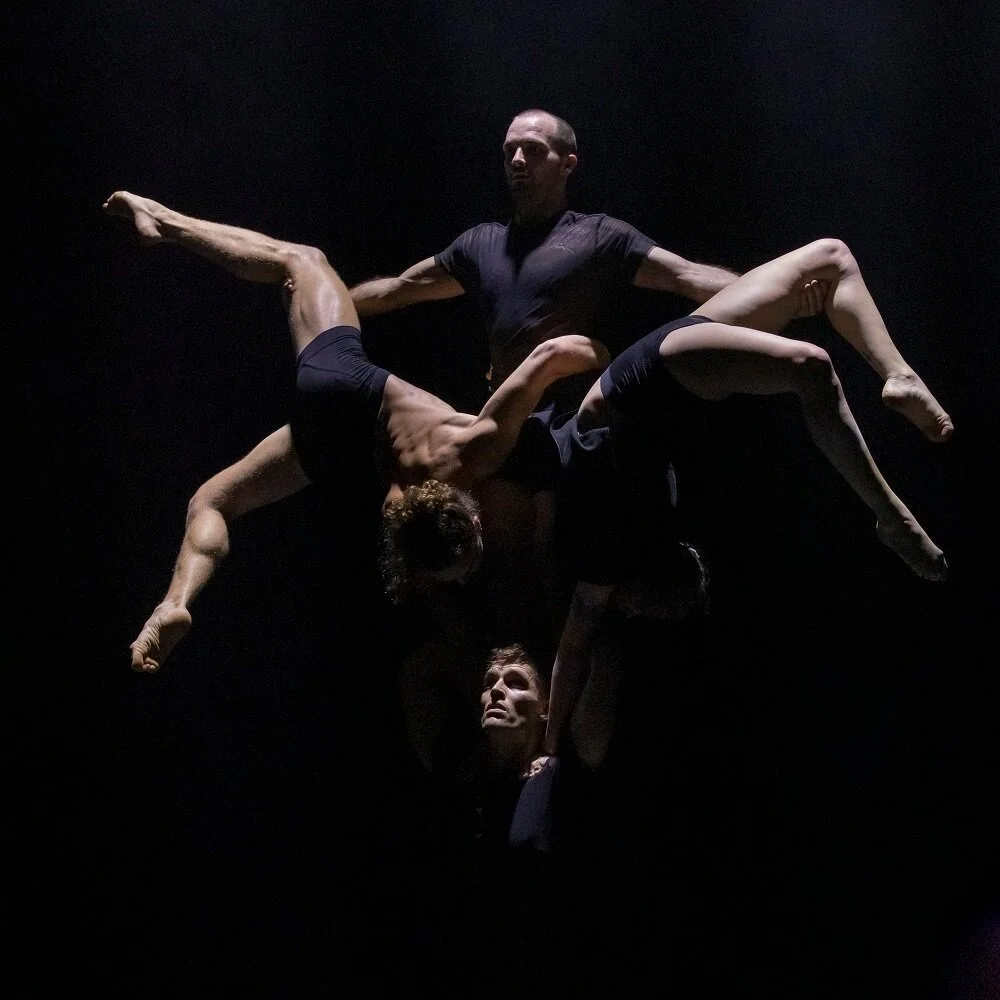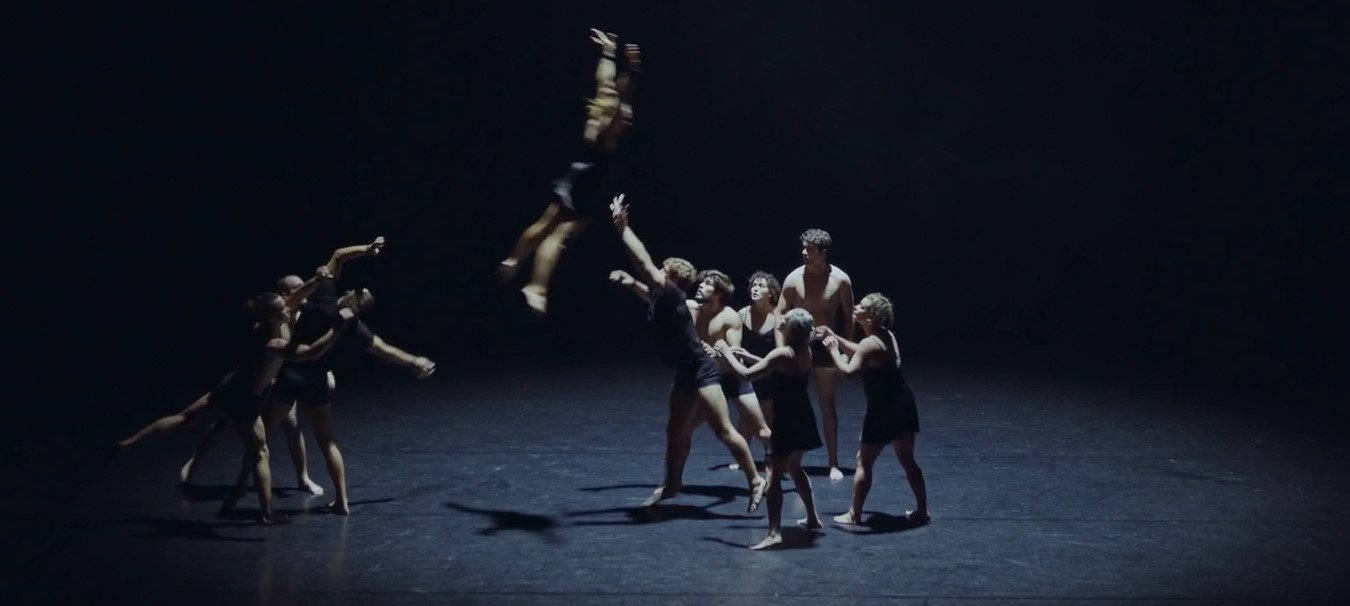The Australian circus group Circa recently debuted a new interpretation of Stravinsky’s The Rite of Spring. They called it Sacre.
A few days before I saw the show, I spoke about it with a woman in my pottery class who’d attended an earlier showing, and who summed it up in a tentative way as “very homoerotic.” This is hardly a brag, but I’ve seen nearly half a dozen performances of The Rite of Spring, the first and most memorable of which contained more nude bodies onstage than I (a prudish 17-year-old at the time) had seen in all the years of my life. So, “very homoerotic” was pretty much what I expected.
Take that first viewing, for example. No one did erotic Stravinsky better than Compagnie Marie Chouinard, whose choreography that was so libidinous that several people left the theatre. (It didn’t help that it was in a double bill alongside the deceivingly tame 24 Chopin Preludes).
Marie Chouinard’s Le Sacre du Printemps. Admittedly, the spindly growths are a little un-sexy, but their faces look just like The Ecstasy of Saint Teresa.
There is nothing erotic (homo or otherwise) about Circa’s new interpretation — it’s horror. It begins in a darkness so complete it looks grainy, and they let that darkness hover long enough for the audience’s imagination to awaken. Then, there is a long, dissonant, low droning, like a double bass warming up, punctuated only by the performers’ breathing. In soft circles of light, they start to play at horror archetypes: the not-quite-rightness of a monster’s walk; a lone girl swaying; creatures that consume everyone they encounter until they must operate with far too many limbs.
Stravinsky joins us in the second half. The Rite of Spring is already a frightening piece of music. The original ballet synopsis involves the ritual sacrifice of a young girl who dances herself to death at the behest of a circle of sage elders, though there are conflicting ideas about whether the music or the narrative came first, or whether the narrative is necessary at all. It caused “near-riots” at its initial 1913 performance, and anyone who hears it for the first time can probably deduce why. In a letter to a Russian conductor, Stravinsky said the piece described “the mystery and great surge of the creative power of Spring.”
Gone were the flowers and fawns of pastoral spring imagery, replaced with a heaving, violent explosion of new life. In essence, a horror show.
Too many limbs.
Why are we so afraid of the natural world, when we ourselves are a part of it?
Perhaps there are two different types of natural horror. The first is the sublime. Mary Shelley’s Frankenstein, with its unparalleled arctic imagery, is my favourite example of this. Whereas you can observe and enjoy (that is, act upon) a pleasing meadow, the sublime inverts this relationship. You are utterly powerless in the face of the great and terrible beauty of an arctic plain or jagged mountain peak. In fact, you are beyond powerless. The sublime is alienating, above all — our inability to comprehend it through reason or action renders us obsolete.
The second type of natural horror is the organic. Consider this: there is a long trail of ivy growing through my window pane and into my living room. It has horrified me since its first curious tendril broke though. It is a kind of natural violation, coming in just where a person might rest their head on the back of the sofa, so that it is hardly a stretch to imagine one long ivy arm reaching around your neck. As I watched the Circa performers contort and contract, I thought a lot about this ivy and why organic horror so particularly disturbing.
Where sublime horror is alienating, organic horror is consuming. It absorbs the human, drags us into an amoral natural world where we are complicit in everything we ordinarily find abject and abhorrent. I would include so-called ‘body horror’ in this category; not to mention that circus itself is already about the wonders and horrors of the human animal. It’s all muscles, balance, flight, and risk.
In her essay collection Strangers (its cover, funnily enough, featuring a strand of ivy with two wide, unblinking eyes), Rebecca Tamás takes a long look at this “terrible intimacy of the nonhuman with us.” She describes a Clarice Lispector character called G.H. during an encounter with a cockroach. Naturally, G.H. is horrified and disgusted by the unexpected appearance of this single brown cockroach, so much so that the “boundaries of her contained and individualistic selfhood begin to corrode.” Gawking and silent, she is forced to leave human singularity behind and recognize her place in the natural world.
“How opulent this silence is,” writes Lispector. “It is the accumulation of centuries. It is the silence of the cockroach looking. The world looks at itself in me.”
The experience is frightening, beyond language, as circus and dance are beyond language. And, like Sacre, it is far beyond the erotic. Eroticism is deeply aesthetic and cerebral, distinct from things that are strictly sexual. This organic world of sex, death, life, and violence has nothing to say and no beauty to offer.
Watching Sacre, my partner was particularly disturbed by the bodies being thrown. This comes from her deep-seated fear of seeing a person get hit by a car, a fear which is itself rooted in the knowledge that the human body is so weak and easily maimed. Seeing a body thrown by other bodies or by a vehicle’s sudden impact reduces the human being, with all its wonderful creative and critical capacities, to an object — an it. Perhaps ‘reduces’ is the wrong word, since we are already objects. It reminds — organic horror reminds us that there are no boundaries between us and the rest of nature, that we are “viscerally and urgently alive in a space of constant becoming,” and sometimes we become something else. Blood on the roadside. Flesh for the worms. “Such a space,” writes Tamás, “is terrifyingly amoral, beyond good and bad, primal in its focus on bringing more life into existence.”
Despite a self-proclaimed dislike of horror, my taste has grown ever more ‘creepy’ over the past decade. I’m drawn to many-legged ceramics, houseplants that ooze, portraits of contorted faces, disturbing avant-garde circus — the more earthly and unsettling the better. In her work, Tamás asks what it might be like to extend our hospitality to the horror of the natural world. Invite it inside. Like the worst of all house guests, it will uproot any illusions you had of a genteel life and consume you whole. Stare long enough at anything with too many limbs and you will sink wordlessly into horror at your own body’s ability to crawl, many-legged, to survive. Watch a stem of ivy push through your window frame and you’ll discover your skin is just as porous — that there’s no boundary at all between the organic matter of your body and the plants breaking in. This is precisely the same disturbing and delightful terror I felt watching a dozen acrobats perform the “mystery and great surge of the creative power of Spring.”
Days after the show, I looked up the etymology of Sacre, the French for sacred. It’s from the Latin ‘sacer’, which also gives us saint and sacrifice. Curiously, it is closely related to sanctuary. So, do we open the doors?
Just lifeforms carrying each other.




